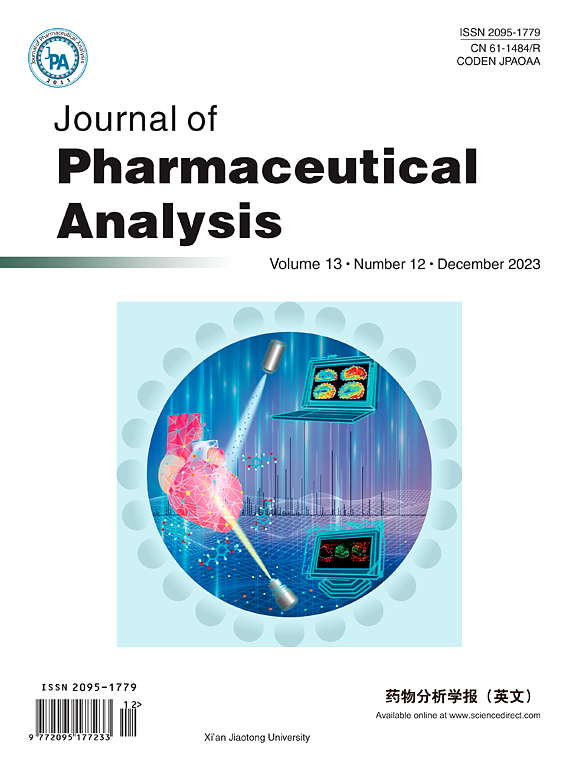作为微波增敏剂的铁铜双金属有机框架,利用微波热疗和化学动力疗法联合治疗肿瘤
IF 8.9
1区 医学
Q1 PHARMACOLOGY & PHARMACY
引用次数: 0
摘要
微波热疗(MWTT)作为一种治疗肿瘤的方法,缺乏特异性,需要敏化剂。大多数报道的微波敏化剂都是单金属有机框架(MOFs),它们必须加载离子液体才能提高在 MWTT 中的性能。同时,微波透射治疗很少与其他治疗方式相结合。在此,我们采用水热法合成了一种新型铁铜双金属有机框架 FeCuMOF(FCM),并用甲基聚乙二醇(mPEG)对其进行了进一步改性。所获得的FeCuMOF@PEG(FCMP)在低功率微波辐照下具有显著的加热性能,还可作为新型纳米粒子酶催化过氧化氢分解,产生大量活性氧(ROS)消耗谷胱甘肽,阻止肿瘤细胞在化学动力学治疗过程中清除ROS。FCMP 可生物降解,具有良好的生物相容性,易于代谢,不会产生毒副作用。最后,它还被证明是一种适用于 T2 磁共振成像(MRI)和.NET 技术的制剂。这种新型双金属纳米结构可成功实现两种肿瘤治疗模式(MWTT 和化学动力学治疗)和双重成像模式(核磁共振成像和微波热成像)。我们的研究成果是集肿瘤诊断和治疗于一体的突破性进展,为开发新型微波增敏剂提供了参考。本文章由计算机程序翻译,如有差异,请以英文原文为准。
An Fe-Cu bimetallic organic framework as a microwave sensitizer for treating tumors using combined microwave thermotherapy and chemodynamic therapy
Microwave thermotherapy (MWTT), as a treatment for tumors, lacks specificity and requires sensitizers. Most reported microwave sensitizers are single-metal organic frameworks (MOFs), which must be loaded with ionic liquids to enhance the performance in MWTT. Meanwhile, MWTT is rarely combined with other treatment modalities. Here, we synthesized a novel Fe-Cu bimetallic organic framework FeCuMOF (FCM) by applying a hydrothermal method and further modified it with methyl polyethylene glycol (mPEG). The obtained FeCuMOF@PEG (FCMP) showed remarkable heating performance under low-power microwave irradiation; it also acted as a novel nanoparticle enzyme to catalyze hydrogen peroxide decomposition, producing abundant reactive oxygen species (ROS) to deplete glutathione and prevent ROS clearance from tumor cells during chemodynamic treatment. The FCMP was biodegradable and demonstrated excellent biocompatibility, allowing it to be readily metabolized without causing toxic effects. Finally, it was shown to act as a suitable agent for T2 magnetic resonance imaging (MRI) and . This new bimetallic nanostructure could successfully realize two tumor treatment modalities (MWTT and chemodynamic therapy) and dual imaging modes (MRI and microwave thermal imaging). Our findings represent a breakthrough for integrating the diagnosis and treatment of tumors and provides a reference for developing new microwave sensitizers.
求助全文
通过发布文献求助,成功后即可免费获取论文全文。
去求助
来源期刊

Journal of Pharmaceutical Analysis
Chemistry-Electrochemistry
CiteScore
16.20
自引率
2.30%
发文量
674
审稿时长
22 weeks
期刊介绍:
The Journal of Pharmaceutical Analysis (JPA), established in 2011, serves as the official publication of Xi'an Jiaotong University.
JPA is a monthly, peer-reviewed, open-access journal dedicated to disseminating noteworthy original research articles, review papers, short communications, news, research highlights, and editorials in the realm of Pharmacy Analysis. Encompassing a wide spectrum of topics, including Pharmaceutical Analysis, Analytical Techniques and Methods, Pharmacology, Metabolism, Drug Delivery, Cellular Imaging & Analysis, Natural Products, and Biosensing, JPA provides a comprehensive platform for scholarly discourse and innovation in the field.
 求助内容:
求助内容: 应助结果提醒方式:
应助结果提醒方式:


